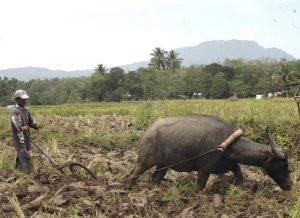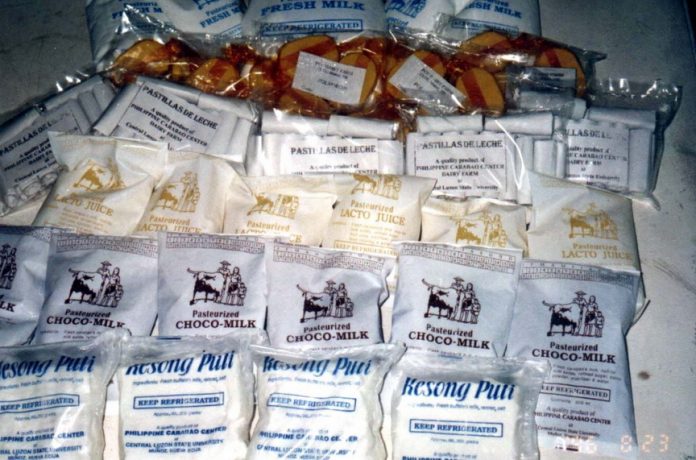“We cannot be forever dependent on imported milk and dairy products. Our farmers could raise dairy animals. This is a P25-billion industry annually.” — President Rodrigo R. Duterte
***
Filipinos are not known for their drinking habits of milk. But in recent years – due to the advertisements in television, radio and newspapers – milk consumption has increased considerably. Parents know the importance of milk and other dairy products for the health of their children.
“In spite of the huge demand for milk and dairy products, the Philippines has always been dependent on importation to fill up the requirements of the growing market,” wrote Secretary Emmanuel F. Piñol of the Department of Agriculture in his book, Feeding Millions: The Duterte Food Security Blueprint.
To drive his point, Piñol cited the 2009 data. That year, the local dairy production was a measly 14,300 metric tons which “was less than one percent of the total national consumption.” In 2010, the milk and dairy products importation had a value of about $588-million, roughly P28-billion.
“Simple computation shows that if only Philippine dairy farmers could produce only 1 percent of the country’s milk and dairy requirements, it would mean an infusion of P2.8-billion in fresh money into the agriculture sector,” Piñol surmised.
According to the agriculture head, the failure of the government to develop the dairy industry in the country is “a huge loss of income opportunity for the Filipino farmers.”
Because of low milk production, most Filipino children suffer from what experts called as chronic malnutrition, or stunting rate for children under 5 years old. Children who suffer from chronic malnutrition fail to grow to their full genetic potential, both mentally and physically.
A survey conducted by the Food and Nutrition Research Institute (FNRI) and released in 2015 showed chronic malnutrition is at its worst in 10 years and this may get worse unless necessary steps are soon taken.
 In a press statement, it was said that one of the major initiatives of the agriculture department is the milk feeding program.
In a press statement, it was said that one of the major initiatives of the agriculture department is the milk feeding program.
“But where do we get enough milk to feed Filipinos, especially the children?” asked Dr. Eufrocina DP. Atabay of the DA’s Philippine Carabao Center (PCC). “What aggravates this situation is that there is a low number of dairy herd population…”
In terms of production, 66% of the milk produced in the Philippines comes from dairy cattle, 33% from carabaos and only 1%from dairy goats.
Another problem: the dairy animals, particularly cattle and carabao, are being left unproductive for a long time. “This will result to low reproduction efficiency and economic loss,” pointed out Dr. Atabay, who specializes in reproductive biotechnology.
The human population continues to grow, both on a global and national scale. It is but obvious that there is a need for the development of dairy industry. That’s where the PCC comes in through its program, “The Role of Assisted Reproduction in Dairy Industry Development.”
Dr. Atabay and her team are working together to increase dairy herd buildup in the country. In addition, the whole team wants also increase dairy herd not only in terms of quantity but also the herd’s genetic quality.
One technology the team is doing is through artificial insemination (AI). This process of simulated reproduction involves extracting sperm from a quality male buffalo and injecting the sperm into the reproductive tract of a female buffalo.
According to PCC, AI services are done nationwide by trained private barangay-based AI technicians as well as technicians of local government units, among others. AI is used to breed animals with higher productivity for both milk and meat by harnessing select animals’ excellent genetic materials.
Two months after the AI, the team checks the presence of fetus inside the carabao. The team also uses pregnancy test on the animal to determine if the breeding is successful “so we can detect non-pregnancy at the soonest time possible,” said Atabay.
Doing so helps to prevent animals who can be productive to be unproductive for too long. This scenario (unproductivity of animals for extended periods), according to Atabay, would be costly for farmers and breeders.
Embryo transfer is another technology being employed for enhanced genetic improvement for better quality carabaos. The scientists collect quality embryos from one female buffalo for transfer to another female buffalo. The actual transfer is undertaken using AI as well.
PCC also conducts in vitro fertilization, or the incubation of the sperm and egg in a petri dish. After this, the scientists do further culture and then perform embryo transfer. In some instances, the group induces the buffalo to produce more eggs in order to get more embryos, thus having more offsprings. Excess embryos are preserved for future use.
“Indeed, there are many ways of producing the embryo,” said Dr. Atabay.
For generations, the carabao has been Filipino farmer’s best friend. But if no concerted effort is made to save them from disappearing in this part of the world, they may soon become extinct.
“If we don’t act fast enough, we may lose our carabaos forever,” deplores Roy C. Alimoane, the director of the Mindanao Baptist Rural Life Center (MBRLC) Foundation, Inc., a non-government organization based in Kinuskusan, Bansalan, Davao del Sur.
Since 1990, the number of carabao population has been declining. “The carabao population growth pattern from 1991 to 2010 is characterized by a period of decline (1991–1994) and a period of erratic growth (1995–2010), that is, increasing from 1994 to 1998, tapering off until 2000 then increasing again from 2001 to 2007 and tapering off from then on,” the PCC reports.
Dr. Valente Villegas, author of Carabao Husbandry, once wrote: “The carabao has established itself in the economic life and heart of the Filipino farmer. The success and stability of a farmer’s profession or livelihood are directly linked with it – mainly as a work animal.”
And they are also a good source of milk. According to PCC, carabao’s milk is an almost “complete food” because it contains protein, fat, lactose, vitamins and minerals, and water.
Carabao’s milk is richer and creamier than cow’s or goat’s milk due to its high percentage of milk fat which is also a good source of energy. “The water buffalo milk is considered the finest among dairy animal milk,” said Dr. Libertado C. Cruz, former PCC executive director.







